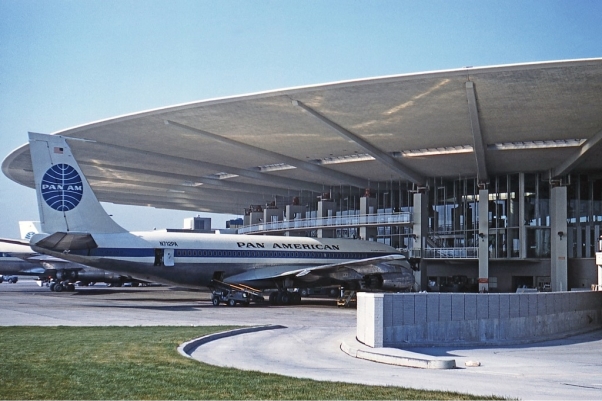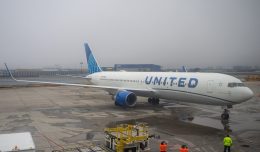Ask any passenger who has boarded a flight at John F. Kennedy Airport’s Terminal 3 in the last 20 years how their experience was, and you probably won’t hear too many positive comments. In fact, you’ll probably hear comments more like “that place is disgusting,” or “this is how New York welcomes airline passengers?”
JFK’s terminal 3 was originally built in 1960 and was later named the Pan Am Worldport. Designed by Ives, Turano & Gardner Associated Architects and Walther Prokosch of Tippets-Abbett-McCarthy-Stratton, the Worldport helped Pan American Airways to usher in the jet aircraft age. In fact, the first ever commercial Boeing 747 flight departed from the Pan AM Worldport. Once the world’s largest airline terminal, it has since fallen into a state of great disrepair.
The Wrecking Ball
Delta Air Lines is the terminal’s current tenant, but not for much longer. As a part of the airline’s vast improvements at JFK, the Worldport is slated for total demolition within the next few years. The removal of the Worldport will make way for additional aircraft parking between terminals two and four.
Although the iconic terminals fate seems sealed, a group named Save the Worldport is attempting to salvage at least part of the history. Kal Savi and Anthony Stramaglia head the group’s uphill battle to prevent the Worldports destruction.
The Worldport is made up of two separate sections, as an addition was built in 1971. “Basically, the building was a victim of the success and growth of air travel,” said Kal Savi. “It was designed at the time when propellers were making way for jet planes, and then when the 747 came along…it certainly didn’t have the capacity to cope with it.”
“The build was a treasure, a gem, when it opened up. I wouldn’t be fighting so hard for this building if I had not seen what they planned to do with it, [which] was to just demolish and pave over it with concrete for additional ramp parking,” said Savi.
While Save the Worldport is fighting for preservation, they do not believe that the entire terminal needs to be saved. Savi says that the 1971 expansion to the Worldport increased the footprint by 650 percent over the original. “What I’d like to see is only the original rotunda section be saved, make it look like the 60’s. Everything old is new again. I see so many possible uses for it,” added Savi.
A Model Example
Just down taxiway Alpha from the Worldport sits the old TWA Flight Center, which has been preserved and is currently undergoing restoration. When JetBlue outgrew their home at the Terminal 6 Sundrome (which was recently demolished), they built a new terminal behind the TWA Flight Center, allowing for history to be preserved. The TWA Flight Center is slowly being refurbished, and is periodically open to the public.
So why was the TWA Flight Center able to be saved, while the Pan Am Worldport faces imminent destruction? One theory is that because the Worldport is not associated with any well-known architects, it has trouble garnering recognition from influential people. The TWA Flight Center, however, benefited from being the product of famed architect Eero Saarinen, who also designed the Gateway Arch in St. Louis, as well as the main terminal at Washington Dulles International Airport.
Road Block
The preservation group says they have seen nothing but roadblocks from their actions thus far. Delta will not comment on question regarding the preservation of the Worldport, instead directing all questions to the Port Authority, a government agency not known for their communications skills.
Savi explains that their efforts have yielded little response from the agencies involved with the Worldport. “We throw out ideas in the hope of getting feedback. It can be positive, it can be negative. But, when you get no feedback, what can you do?”
The lack of communication has been a key issue in getting the building declared historic by the State of New York. When asked about the process of filing for historic status, Stramaglia explained a major road block. “The owner of the building has to approve it before the paperwork even gets considered,” said Stramaglia. “They can’t do anything without the Port Authority’s approval,” added Stramaglia.
Interestingly, New York’s State Historic Preservation Office in 1988 deemed that the Worldport was eligible to list as a historic place. From that point and up until 2001, no action was taken. In 2001, the Port Authority submitted a report to the preservation office with the intent of revoking the eligibility status. In that determination, the preservation office based their decision on the fact that they decided there was too much loss of historic materials, design workmanship, as well as the “feeling and association” with the original building.
Save the Worldport is currently trying to overturn that 2001 decision.
Can Preservation and Progress Coexist?
Some critics of the preservation movement say that saving another terminal at JFK will only impede future expansion, and hurt operations in the future. “We don’t want to stop any progress at JFK,” said Stramaglia. They believe that saving at least part of the Worldport can coexist with much needed operations expansions.
While it is not practical to save every piece of history, Save the Worldport is arguing that we must pause for a moment and consider that once this piece of aviation history is lost, it is lost forever. Progress and change are inevitable, but the destruction of aviation history shouldn’t be.









